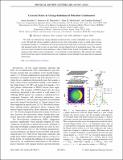Files in this item
Crescent states in charge-imbalanced polariton condensates
Item metadata
| dc.contributor.author | Strashko, Artem | |
| dc.contributor.author | Marchetti, Francesca M. | |
| dc.contributor.author | MacDonald, Allan H. | |
| dc.contributor.author | Keeling, Jonathan | |
| dc.date.accessioned | 2020-08-07T16:30:04Z | |
| dc.date.available | 2020-08-07T16:30:04Z | |
| dc.date.issued | 2020-08-07 | |
| dc.identifier | 269012247 | |
| dc.identifier | 405885f2-9bc8-42f1-897b-9d23fbeb98ca | |
| dc.identifier | 000557302300011 | |
| dc.identifier | 85089962823 | |
| dc.identifier.citation | Strashko , A , Marchetti , F M , MacDonald , A H & Keeling , J 2020 , ' Crescent states in charge-imbalanced polariton condensates ' , Physical Review Letters , vol. 125 , no. 6 , 067405 . https://doi.org/10.1103/PhysRevLett.125.067405 | en |
| dc.identifier.issn | 0031-9007 | |
| dc.identifier.other | ArXiv: http://arxiv.org/abs/2001.07726v1 | |
| dc.identifier.other | ORCID: /0000-0002-4283-552X/work/78528015 | |
| dc.identifier.other | ORCID: /0000-0001-8082-1826/work/78528202 | |
| dc.identifier.uri | https://hdl.handle.net/10023/20429 | |
| dc.description | Funding: AS acknowledges support from the EPSRC CM-CDT (EP/L015110/1) and a travel award from the Scottish Universities Physics Alliance. AS, AHM and JK acknowledge financial support from a Royal Society International Exchange Award, IES\R2\170213. FMM acknowledges financial support from the Spanish Ministry of Science and Innovation through the project No. MAT2017-83772-R and the “María de Maeztu” Programme for Units of Excellence in R&D (CEX2018-000805-M). JK acknowledges financial support from EPSRC program “Hybrid Polaritonics” (EP/M025330/1). AHM acknowledges support from Army Research Office (ARO) Grant # W911NF-17-1-0312 (MURI). This work was performed in part at Aspen Center for Physics, which is supported by National Science Foundation grant PHY-1607611 and partially supported by a grant from the Simons Foundation. | en |
| dc.description.abstract | We study two-dimensional charge-imbalanced electron-hole systems embedded in an optical microcavity. We find that strong coupling to photons favors states with pairing at zero or small center of mass momentum, leading to a condensed state with spontaneously broken time-reversal and rotational symmetry, and unpaired carriers that occupy an anisotropic crescent-shaped sliver of momentum space. The crescent state is favoured at moderate charge imbalance, while a Fulde–Ferrel–Larkin–Ovchinnikov-like state — with pairing at large center of mass momentum — occurs instead at strong imbalance. The crescent state stability results from long-range Coulomb interactions in combination with extremely long-range photon-mediated interactions. | |
| dc.format.extent | 7 | |
| dc.format.extent | 990282 | |
| dc.language.iso | eng | |
| dc.relation.ispartof | Physical Review Letters | en |
| dc.subject | QC Physics | en |
| dc.subject | TK Electrical engineering. Electronics Nuclear engineering | en |
| dc.subject | DAS | en |
| dc.subject.lcc | QC | en |
| dc.subject.lcc | TK | en |
| dc.title | Crescent states in charge-imbalanced polariton condensates | en |
| dc.type | Journal article | en |
| dc.contributor.sponsor | EPSRC | en |
| dc.contributor.sponsor | The Royal Society | en |
| dc.contributor.institution | University of St Andrews. School of Physics and Astronomy | en |
| dc.contributor.institution | University of St Andrews. Condensed Matter Physics | en |
| dc.identifier.doi | 10.1103/PhysRevLett.125.067405 | |
| dc.description.status | Peer reviewed | en |
| dc.date.embargoedUntil | 2020-08-07 | |
| dc.identifier.url | https://journals.aps.org/prl/accepted/3c070Ya4C9413e67903c29933ec5687d591961571 | en |
| dc.identifier.grantnumber | EP/M025330/1 | en |
| dc.identifier.grantnumber | IES/R2/170213 | en |
This item appears in the following Collection(s)
Items in the St Andrews Research Repository are protected by copyright, with all rights reserved, unless otherwise indicated.

